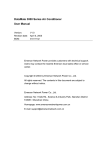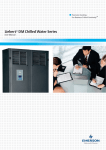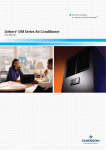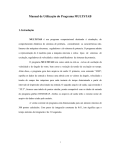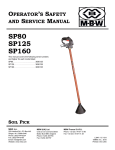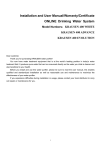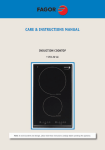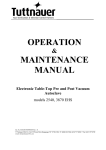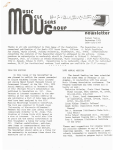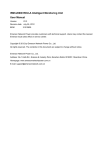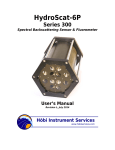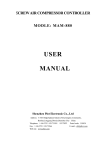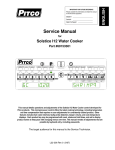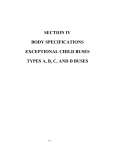Download user manual.indd - Emerson Network Power
Transcript
Partnerships TM for Business-Critical Continuity Liebert DM User Manual Contents Chapter 1 Introduction............................................................................................................1 1.1 Product Model Information ........................................................................................1 1.2 Functions ..................................................................................................................1 1.2.1 Controller ........................................................................................................2 1.2.2 Evaporator ......................................................................................................2 1.2.3 Condenser ......................................................................................................3 1.3 Environment Requirement ........................................................................................3 1.3.1 Operating Environment ...................................................................................3 1.3.2 Storage Environment ......................................................................................4 1.4 Main Parts.................................................................................................................4 1.4.1 Evaporator Module..........................................................................................4 1.4.2 Condensing Module ........................................................................................4 1.4.3 Pressure Switch ..............................................................................................4 1.5 Optional Parts ...........................................................................................................5 1.5.1 Humidifier........................................................................................................5 1.5.2 Heater .............................................................................................................5 1.5.3 Remote Monitoring Software ..........................................................................5 Chapter 2 Mechanical Installation ..........................................................................................6 2.1 Installation Considerations ........................................................................................6 2.2 Equipment Inspection................................................................................................6 2.3 System Installation Arrangement ..............................................................................7 2.3.1 General Arrangement .....................................................................................7 2.3.2 System Installation Illustration ........................................................................7 2.3.3 Unit Mechanical Parameters ...........................................................................9 2.4 Evaporator Installation ............................................................................................ 11 2.4.1 Room Preparation......................................................................................... 11 2.4.2 Location Consideration ................................................................................. 11 2.4.3 Installation Procedure ................................................................................... 12 2.5 Condenser Installation ............................................................................................ 13 2.5.1 Location Considerations ............................................................................... 13 2.5.2 Installation Procedure ................................................................................... 13 2.6 Piping Connections ................................................................................................. 15 2.6.1 General Principle For Piping ......................................................................... 15 2.6.2 Pipe Connections Required .......................................................................... 16 2.6.3 Piping For Evaporator ................................................................................... 16 2.6.4 Connecting Refrigerant Lines ....................................................................... 18 2.6.5 Notice For Refrigerant Piping........................................................................ 19 2.6.6 Notice For Quick Connect Fittings ................................................................ 19 2.7 Adding Refrigerant To Long Piping Unit.................................................................. 20 2.8 Checklist For Mechanical Installation ...................................................................... 20 Chapter 3 Electrical Installation............................................................................................ 22 3.1 Remove Electric Plate............................................................................................. 22 3.2 Connecting The Power Supply Of Evaporator ........................................................ 23 3.3 Connecting The Power Supply Of Condenser ........................................................ 24 3.4 Connecting Control Cables ..................................................................................... 24 3.4.1 Remote Unit Shutdown, Smoking And Fire Sensing..................................... 25 3.4.2 Custom Alarms ............................................................................................. 26 3.4.3 General Alarm............................................................................................... 26 3.4.4 Changeover And Standby Unit Enable ......................................................... 26 3.4.5 Monitoring Interface ...................................................................................... 26 3.5 Checklist For Completing Installation ...................................................................... 27 Chapter 4 System Commission............................................................................................ 28 4.1 Inspection Before/After Start-up.............................................................................. 28 4.2 Speed Controlling For Condenser Blower............................................................... 29 4.3 System Function Testing......................................................................................... 29 4.3.1 Cooling Operation ......................................................................................... 29 4.3.2 Heating Operation......................................................................................... 29 4.3.3 Humidification Operation............................................................................... 30 4.3.4 Dehumidification Operation........................................................................... 30 4.3.5 Checking Refrigerant Amount Of The Lee Temp Condenser ....................... 30 Chapter 5 Microprocessor Control ....................................................................................... 31 5.1 LCD Screen ............................................................................................................ 31 5.2 Control Buttons .......................................................................................................31 5.3 Setpoints .................................................................................................................32 5.4 Control Screen ........................................................................................................34 5.4.1 Off Screen..................................................................................................... 34 5.4.2 On Screen..................................................................................................... 34 5.4.3 Normal Screen .............................................................................................. 34 5.4.4 Password Screen.......................................................................................... 35 5.5 Main Menu .............................................................................................................. 36 5.6 Alarm Menu............................................................................................................. 36 5.6.1 Alarm Status ................................................................................................. 37 5.6.2 Alarm History ................................................................................................ 37 5.6.3 Alarm Setpoint .............................................................................................. 38 5.6.4 Alarm Output................................................................................................. 38 5.6.5 Custom Alarm ............................................................................................... 39 5.6.6 Service Interval ............................................................................................. 39 5.7 Setpoints .................................................................................................................40 5.8 System Status.........................................................................................................41 5.8.1 Tem/ Hum ..................................................................................................... 41 5.8.2 Time/Date ..................................................................................................... 41 5.8.3 Output Status................................................................................................ 41 5.8.4 Run Time ...................................................................................................... 42 5.8.5 Comp Run Record ........................................................................................ 42 5.9 System Menu .......................................................................................................... 42 5.9.1 Setup System................................................................................................ 42 5.9.2 Select Options............................................................................................... 44 5.9.3 Sensor Calibrate ........................................................................................... 45 5.9.4 Diagnose....................................................................................................... 45 5.9.5 Change Password......................................................................................... 46 5.9.6 Factory Reset................................................................................................ 46 5.10 Help Menu............................................................................................................. 47 5.10.1 Normal Info ................................................................................................. 47 5.10.2 Service Info ................................................................................................. 48 Chapter 6 Maintenance........................................................................................................ 49 6.1 Electric Board.......................................................................................................... 49 6.2 Evaporator .............................................................................................................. 50 6.2.1 Filter.............................................................................................................. 50 6.2.2 Blower........................................................................................................... 50 6.2.3 Drain Line ..................................................................................................... 51 6.2.4 Heater ........................................................................................................... 51 6.2.5 Humidifier...................................................................................................... 51 6.2.6 Thermal Expansion Valve ............................................................................. 54 6.2.7 High/Low Pressure Switch ............................................................................ 54 6.2.8 Compressor .................................................................................................. 55 6.3 Condenser .............................................................................................................. 57 6.3.1 Refrigeration System .................................................................................... 57 6.3.2 Air Cooled Condensing Units ........................................................................ 57 6.3.3 Low- Temp Adjustment Unit Of Lee Temp Condenser ................................. 57 6.4 Maintenance Inspection Checklist........................................................................... 57 Chapter 7 Troubleshooting................................................................................................... 59 Appendix Control System Menu Structure ........................................................................... 61 Chapter 1 Introduction Chapter 1 1 Introduction 1.1 Product Model Information DM E - 07 M H 1 Revision 1.0 C: Cooling Only O: With Electric Reheat H: With Humidifier and Reheat W: 220V-1 ph-50Hz M: 380V-3 ph-50Hz 07: 7kW Evaporator 12: 12kW Evaporator E: Indoor Unit C: Standard Outdoor Unit; L: Lee Temp Outdoor Unit DataMate 3000 Air Conditioner 1.2 Functions The DataMate3000 is a small precise environmental control system specially designed for electrical system room cooling. Featuring high reliability, high sensible heat ratio and big air volume, the system is suitable for controlling the temperature and humidity (optional) in system or computer room to maintain a favorable environment for precise systems such as sensitive systems, process control systems, communication systems and computers. This system has two models with nominal ratings of 7kW and 12kW respectively, which can be selected according to the actual room heat loads. Each DataMate3000 consists of an indoor direct expansion evaporator module and an outdoor air cooled condensing module. Both modules are installed on the ground. The outdoor unit has two models, standard model and Lee Temp model. The Lee Temp model can be used at lower temperature. Detailed parameters are shown in Table 1-1. The system may also include optional heater and humidifier. Models available for cooling only do not include heater and humidifier. The standard DataMate3000 system includes cooling parts for temperature control. The optional humidity control uses the optional heater and humidifier to keep the favorable humidity. The DataMate3000 system has a controller that can automatically switch over to the required function (cool/heat, dehumidify/humidify) based on the programmed setpoints and room conditions. DataMate 3000 Series Air Conditioner User Manual 2 1.2.1 Chapter 1 Introduction Controller The system controller has a 128×64-matrix dot LCD screen with blue backlight. The man-machine-interface is easy-to-use. Multilevel passwords are configured to prevent unauthorized operation. The program is stored in non-volatile memory. The controller also has functions of high-voltage/low-voltage protection, phase failure protection and phase switchover in case of reverse phase rotation. Users can acquire the accurate running time of major parts by browsing the menu. Expert-level troubleshooting system enables the LCD to display the fault information automatically for convenient maintenance. The controller can store up to 30 history alarms. It can communicate to a host through the RS485 port. The control panel is shown in Figure 1-1. Figure 1-1 1.2.2 Control Panel Evaporator The DataMate3000 system uses a highly efficient fin-tube heat exchanger and a centrifugal blower capable of delivering a high volume of air over a long distance. It also includes a compliance scroll compressor, which has a high energy efficiency ratio and ensures the high reliability of the system. The filter is accessible by opening the front door, which is convenient for maintenance. DataMate 3000 Series Air Conditioner User Manual Chapter 1 Introduction 1.2.3 3 Condenser The condenser includes a high efficiency fin-tube heat exchanger. The blower includes a low noise propeller fan driven by a high performance single-phase motor. The motor is customized to adapt to the power network of base stations, so it can work over a wide voltage range with a high reliability. 1.3 Environment Requirement 1.3.1 Operating Environment Refer to Table 1-1 for detailed operating environmental requirements. Table 1-1 Operating environmental requirements of DataMate3000 system Item Requirement The max. equivalent horizontal distance of the evaporator and condensing modules[1]: 50m; [2] Altitude distance ΔH: -5m≤ΔH≤20m Installation position Installation method Environmental temperature Relative humidity Protection level (Condenser) Evaporator: Vertical, floorstand≥150mm; Condenser: Horizontal discharge Indoor: 0°C~30°C; Outdoor: standard model -15°C~45°C; Lee Temp model -34°C~45°C 30%~80%RH IPX4 Altitude <1000m. The system should be derated where the altitude is higher than 1,000m. Range of operation voltage 380V [-15% ~ +20%] 1. The equivalent length of each component is shown in Table 1-2. 2. A positive altitude distance means that the condenser is mounted above the compressor. A negative altitude distance means that the condenser is mounted below the compressor. Table Liquid line O.D. (inch) 3/8 1-2 The equivalent length of each component Equivalent length (m) 90° elbow 45° elbow T type three-way pipe 0.21 0.10 0.76 1/2 0.24 0.12 0.76 5/8 0.27 0.15 0.76 3/4 0.3 0.18 0.76 7/8 0.44 0.24 1.1 1-1/8 0.56 0.3 1.4 DataMate 3000 Series Air Conditioner User Manual 4 1.3.2 Chapter 1 Introduction Storage Environment Refer to Table 1-3 for detailed storage environmental requirements. Table 1-3 Storage enriromental requirements of DataMate3000 system Item Storage environment Relative humidity Environmental temperature Storage time 1.4 Main Parts 1.4.1 Evaporator Module Requirement Indoor, without dust 5%~95%RH -40°C~70°C The shipment and storage time should not exceed 12 months. Otherwise, the system shall be re-tested The evaporator module consists of an evaporator, a compressor, a heater (optional), blower, controller, humidifier (optional), thermal expansion valve, sight glass and filter dryer. 1.4.2 Condensing Module The condensing module consists of a fan, a condenser and a fan motor. The Lee Temp condenser has an extra low- temp adjustment unit besides the above parts. 1.4.3 Pressure Switch High and low pressure switches are used to protect the refrigerant system. The action point of the high pressure switch is 2.76MPa and the recovery point is 2.1MPa. The action point of the low pressure switch is 0.14MPa, and the recovery point is 0.25MPa. The Lee Temp model condenser has a tank pressure switch to control the onoff of the tank heating belt. The action point of the pressure switch is 1.25MPa and the recovery point is 0.85MPa. DataMate 3000 Series Air Conditioner User Manual Chapter 1 Introduction 1.5 Optional Parts 1.5.1 Humidifier 5 It adds pure water vapor (up to 2.5kg/hour) to the room air to control humidity within the levels recommended for computer system. The humidifier components include the steam canister with automatic flushing circuit, inlet tube, drain, solenoid valve, and steam distributor. Note 1. The electric humidifier should be factory installed and tested. 2. Humidity control is available only if a humidifier is provided. 1.5.2 Heater The optional heater is a ceramic heater with positive temperature coefficient. It is safe and reliable. When the surface temperature is high, it will reduce the heating power to avoid danger caused by over-temperature. There is a temperature switch on the surface of the heater, and it will cut off the power supply of the heater when the surface temperature of the heater is too high. When the surface temperature decreases to normal, the heater will operate again automatically. The technical parameters of the heater are given in Table 1-4. Table 1-4 Item Power Voltage 1.5.3 Technical parameters of the heater Value 2000W 220V Item Current Max temperature Value 9.1A 45°C Remote Monitoring Software The DataMate3000 communicates to the host and receives commands from the host by using its remote monitoring software through a RS485 port. DataMate 3000 Series Air Conditioner User Manual 6 Chapter 2 Mechanical Installation Chapter 2 2.1 Mechanical Installation Installation Considerations The evaporator should always be mounted on the floor in the system or computer room. The condenser can be mounted outdoors or on the floor in another room. Before installing the units, check whether the environment complies with the requirement listed in Table 1-1 in section 1.3 and whether any building alteration is required to run piping, wiring, and duct work. Carefully follow the design drawings and reserve proper clearances. Refer to the submittal engineering dimensional drawings of individual units. 2.2 Equipment Inspection When the DataMate3000 arrives, inspect all items for any visible damage. Do not accept a damaged unit from the shipper. If possible, do not uncrate the system until it is close to its final location. All required assembles are packed and shipped in containers. If you discover any damage when you uncrate the unit, report it to the shipper and to your supplier immediately. DataMate 3000 Series Air Conditioner User Manual Chapter 2 Mechanical Installation 7 2.3 System Installation Arrangement 2.3.1 General Arrangement The system general arrangement diagram is shown in Figure 2-1. The recommended line size is shown in Table 2-1. C ondenser c o il U n id ire c tio n a l va lv e E va p o ra to r c o il T ra p s * e ve ry 6 m o f v e rtic a l lift R e frig e ra n t d is trib u to r L iq u id lin e D is c h a rg e lin e T h e rm a l e x p a n sio n S ig h t va lv e g la ss F ilte r d rie r Va lv e c o re S e n s in g b u lb S u c tio n lin e Va lve c o re S o le n o id v a lv e + S c ro ll c o m p re ss o r M a le q u ick c o n n e c t c o u p lin g F e m a le q u ick c o n n e c t c o u p lin g Figure 2-1 DataMate3000 general arrangement diagram Factory piping Field piping (by others) * Unidirectional valve and traps are optional and not supplied by Emerson. But they are recommended for field installation for proper circuit operation and maintenance. They should be installed on site by technical personnel. + Solenoid valve is part of optional extended piping kit. Table 2-1 2.3.2 Recommended line size Actual capacity Length Discharge line O.D Liquid line O.D 7.5kW (6500 calories; 2.2 tons) 10m 1/2” (12.7mm) 3/8” (9.52mm) 12.5kW (10800 calories; 3.6 tons) 10m 5/8” (15.88mm) 1/2” (12.7mm) System Installation Illustration The evaporator and condenser must stand on the floor or ground. The DataMate3000 can be installed in two ways. One is to install the condenser higher DataMate 3000 Series Air Conditioner User Manual Chapter 2 Mechanical Installation than the evaporator and the other is to install the condenser lower than the evaporator, as shown in Figure 2-2. Condenser Liquid line (not be exposed to sun) Trap Evaporator Protection tube Max. 20m 1:200 Discharge line(slope) 6m Humidifier water supplyline (from water supply tube) Insulation floor Seal and vapor seal Insulation material 1:200 Drain line (trapped outside room) Floor (a) Condenser higher than evaporator Evaporator Liquid line (not be exposed to sun) Seal and vapor seal Protection tube 1:200 Discharge line (slope) Insulation floor Humidifier water supply line (from water supply tube) Condenser Max. 5m 8 Insulation material Floor (b) Condenser lower than evaporator Figure 2-2 DataMate3000 installation illustration DataMate 3000 Series Air Conditioner User Manual 1:200 Drain line (trapped outside the room) Chapter 2 Mechanical Installation Unit Mechanical Parameters The mechanical parameters of the evaporator are shown in Figure 2-3 and Table 2-2. 600 55 0 1900 2.3.3 600 Figure 2-3 60 0 Dimensions of evaporator (unit: mm) The shadow in Figure 2-3 indicates a reasonable service access area. The evaporator can be installed against a wall. Air conditioners with heaters should keep a distance of minimum 150mm from combustible substance. When testing the air conditioner, the exterior fine pressure should be kept below 150Pa lest the air quantity should be low and the heater should overheat, The mechanical parameters of the condenser are shown in Figure 2-4, Figure 2-5 and Table 2-2. DataMate 3000 Series Air Conditioner User Manual 9 Chapter 2 Mechanical Installation 353 353 702 626 1238 702 Figure 2-4 Dimensions of standard condenser (unit: mm) 353 702 702 353 1238 250 250 Figure 2-5 Table 2-2 575 575 626 10 Dimensions of Lee Temp condenser (unit: mm) Mechanical parameters of condenser and evaporator Parameters Cooling capacity (kW) Dimensions (W*D*H) (mm) Net weight (kg) DME07 7.5 600×550×1900 150 DME12 12.5 600×550×1900 160 DMC07 - 702×353×626 34 DMC12 - 702×353×1238 58 DML07 - 952×353×626 53 DML12 - 952×353×1238 95 Models DataMate 3000 Series Air Conditioner User Manual Chapter 2 Mechanical Installation 11 The dimensions of the heater (optional parts) are illustrated below. 35 20 15 11 1750 ± 15 (blue) 14 13 24 50 12 2、3、4、5、6、7、8 10 1 9 1600 ± 15 (brown) 426 ± 1 Figure 2-6 15 Dimensions of heater (unit: mm) 2.4 Evaporator Installation 2.4.1 Room Preparation The room should be well insulated and must have a sealed vapor barrier. Use polyethylene as the vapor barrier of the ceiling and the wall. Paint on concrete walls or floors should be vapor resistant. Note The most important requirement for maintaining environmental control in the conditioned room is the vapor barrier. Incoming fresh air should be kept to a minimum. Incoming outside air adds to the heating, cooling, humidifying loads of the site. It is recommended that outside air be kept below 5% of the total circulated in the room. Doors and windows should be properly sealed to minimize leaks. 2.4.2 Location Consideration Note The DataMate3000 generates water. Water leaks can cause damage to sensitive system nearby. Do not mount units near sensitive systems. Be sure to install a field-supplied pan with a drain line. 1. Try to locate the evaporator in a capacious floor space to ensure normal operation. DataMate 3000 Series Air Conditioner User Manual 12 Chapter 2 Mechanical Installation 2. Avoid locations in confined areas that affect the airflow pattern and result in short cycles and abnormal noise. 3. Do no install the unit in an alcove or at the extreme end of a long, narrow room. 4. Do no install multiple units close to each other. This can result in crossing air patterns, uneven loads and competing operating modes. 5. Do not attach additional devices (such as smoke detectors, and so on.) to the cabinet that will interfere with routine maintenance or service. Figure 2-7 indicates the recommended room location. Recommended location Not recommended Figure 2-7 Installation Procedure 1. Secure the floorstand on the selected location. The outline and dimensions of the floorstand are shown in Figure 2-8. Rubber cushion(8mm) H>150 0 600 55 2.4.3 Recommended room location of evaporator Rubber cushion(8mm) hole for installing expansive bolt(M6×50) or 25×25×2 square tube Sole Steel plate 60×60×4 Figure 2-8 30×30×3 angle iron Floorstand 2. Lay a rubber cushion with 8~10mm thickness, as shown in Figure 2-8. 3. Uncrate the evaporator and place it onto the floorstand. DataMate 3000 Series Air Conditioner User Manual Chapter 2 Mechanical Installation 13 4. Rotate the grille to select the desired air discharge direction, as shown in Figure 2-9. Grille can be rotated in the arrow direction Figure 2-9 Changing air discharge direction 2.5 Condenser Installation 2.5.1 Location Considerations 1. The condenser should be located for maintenance accessibility and away from residential areas. Avoid ground-level sites with public access. 2. Do no locate the condenser directly in the environment that requires low noise. 3. To ensure a satisfactory air supply, locate the condenser in a clean area, away from loose dirt and foreign matter that may clog the heat exchanger. 4. Do not locate the condenser in the vicinity of steam, hot air, or fume exhausts. 5. Do not locate the condenser closer than 450mm from a wall, obstruction or adjacent unit. 6. Avoid areas where heavy snow will accumulate at air inlet and discharge locations. 7. Install a solid base capable of supporting the weight of the condenser. The base should be at least 50mm higher than the surrounding ground and 50mm larger than the dimensions of the condenser base, as shown in Figure 2-9. 2.5.2 Installation Procedure 1. Uncrate the condenser and place it onto the base. 2. Secure the condenser with expansive bolts. The installation sizes are shown in Figure 2-10 & Figure 2-11. DataMate 3000 Series Air Conditioner User Manual 14 Chapter 2 Mechanical Installation 374 394 R6 617 712 Figure 2-10 Condenser installation dimensions (unit: mm) 952 617 374 394 R6 Figure 2-11 Condenser installation dimensions (unit: mm) 3. If multiple condensers are installed up and down, refer to Figure 2-12. DataMate 3000 Series Air Conditioner User Manual Chapter 2 Mechanical Installation 4m 15 Airflow Condensor 0.5m Note: Use 5# angle ironas bracket when installing two condensors up and down. Use 6.5# V-iror as bracket when installing three condensors up and down. Condensor Airflow Bracket 50mm 50mm Mir.50mm Base Figure 2-12 Condensor base Install multiple condensers up and down 2.6 Piping Connections 2.6.1 General Principle For Piping 1. Use copper pipes to connect the evaporator and the condenser. Connections are quick screw thread connections. If the line is too long and straight copper line is used, piping joints must be brazed. 2. Follow standard industry procedures in selection and placement of pipe supports, system evacuation and charging with refrigerant (only when pipeline is very long). The standard refrigerant of this system is R22. 3. Give considerations to pipeline pressure drop, oil return to the compressor, avoidance of oil logging in parts of the system and minimization of noise and vibration. 4. Consult Emerson before installation whether measures such as using extended piping kit are needed if the equivalent length exceeds 50m, or if the vertical difference between the evaporator and condenser exceeds the values in Table 2-3. 5. The recommend values in Table 2-3 are equivalent length (The equivalent length of each component is shown in Table 1-2). The loss of resistance caused by elbows DataMate 3000 Series Air Conditioner User Manual 16 Chapter 2 Mechanical Installation and valves has been taken into consideration. The installer should confirm if these values are appropriate for site conditions. Table 2-3 Vertical difference between compressor and condenser Condenser above compressor Condenser below compressor 2.6.2 Max.: 20m Max: 5m Pipe Connections Required Refer to Figure 2-2. The following pipe connections are required: 1. A drain line from the evaporator coil drain pan 2. Connections between the evaporator and condenser (discharge line and liquid line) The following pipe connections are required if condensate pump and humidifier are used. 1. A drain line from the condensate pump 2. A water supply line to the humidifier If a humidifier is used, the tube fitting connection of the humidifier for water inlet should be connected to a water supply line. Note During start-up, ensure that all piping connections have been completed without leaks. 2.6.3 Piping For Evaporator The base cutout locations of the evaporator are shown in Figure 2-13. Back view Drain line Discharge line Liquid line Water supply line Power cable Cutout Figure 2-13 Base cutout locations of evaporator DataMate 3000 Series Air Conditioner User Manual Chapter 2 Mechanical Installation 17 The pipe junctions inside the evaporator unit are shown in Figure 2-14. No humidifier With humidifier (Optional) . Chilled water drain outlet (O.D 20mm) Discharge line DME07 line O.D.1/2" connection O.D.3/4"(20mm) DME12 line O.D.5/8" connection O.D.7/8"(22mm) Liquid line DME07 line O.D.3/8" connection O.D.5/9"(16mm) DME12 line O.D.1/2" connection O.D.3/4"(20mm) Figure 2-14 Pipe junctions inside evaporator unit Connecting evaporator drain line Use a 20mm(3/4 in.) connection with hose barbs to connect the drain line to the chilled water drain outlet of the evaporator shown in Figure 2-14 and fix the drain line outdoors with one of the hose barbs. The drain line must be located so it will not be exposed to freezing temperature. The drain line should be the full size of the drain connection. Note The pipe material of the drain line must be rated for the temperature of boiling water. Use galvanized steel, PP-R or other suitable material for the drain line. Connecting humidifier water supply line(if applicable) Connect the humidifier (shown in Figure 2-14 and Figure 2-15) and the water supply line with a pipe through the cutout shown in Figure 2-13. The units supplied with the optional humidifier package have a 3/4-inch tube fitting connection for water inlet. Supply pressure range is 1 kgf/cm2 to 8kgf/cm2. DataMate 3000 Series Air Conditioner User Manual 18 Chapter 2 Mechanical Installation A shut-off valve should be installed in this line to isolate the humidifier for maintenance. Rubber gland Connection for humidifier water inlet (3/4”) Figure 2-15 Tube fitting connection for humidifier water inlet 2.6.4 Connecting Refrigerant Lines Connecting discharge line Connect the discharge line between the evaporator (refer to Figure 2-14) and the condenser (refer to Figure 2-16) through the cutout of the evaporator shown in Figure 2-13. Note Pitch the discharge line a minimum of 5mm per meter (1:200). Use a heat-isolation material to pack around the tubes if the discharge line goes through the area controlled by the air conditioner (including under isolation floor). 1. Removing plate 2.Refrigerant line connection Liquid line DMC07/DML07 (line O.D. 3/8"; connection O.D. 5/8" (16mm) DMC12/DML12 (line O.D. 1/2"; connection O.D. 3/4" (20mm) Discharge line DMC07 /DML07 (line O.D. 1/2"; connection O.D. 3/4" (20mm) DMC12 /DML12 (line O.D. 5/8"; connection O.D. 7/8" (22mm) Figure 2-16 Piping interface inside condenser DataMate 3000 Series Air Conditioner User Manual Chapter 2 Mechanical Installation 19 Connecting liquid line Connect the liquid line between the evaporator (shown in Figure 2-14) and the condenser (shown in Figure 2-16) through the cutout of the evaporator shown in Figure 2-13. 2.6.5 Notice For Refrigerant Piping 1. The pressure drop of the liquid line should be less than 0.4kgf/cm2. 2. The copper lines, an insulated discharge line and a liquid line, are available from the factory in length of 10 meters. Contact Emerson or your sales agency for longer piping runs. 3. Quick connects are also available to enable field supplied piping. 4. Handle the lines with care so that they will not get kinked or damaged. Use tube benders and make all bends before making connections to either end. 5. If all refrigeration piping should be installed with high temperature brazed joints, silver brazed joint should be used. 6. Use prevailing refrigeration practices in piping supports, leak testing, dehydration, and charging of the refrigeration circuits. Use vibration isolating support to isolate the refrigeration piping from the building. 7. Use a soft and flexible material to pack around the tubes to protect them when sealing openings in walls and to reduce vibration transmission. 8. When installing the condenser above the evaporator for 6 meters, the discharge line should be trapped at the evaporator. This trap will retain refrigerant oil in the off cycle. When the unit starts, oil in the trap is carried up the vertical riser and returns to the compressor. 2.6.6 Notice For Quick Connect Fittings Take great care when connecting the quick connect fittings. Read through the following steps before making connection. 1. Remove protector caps and plugs. 2. Carefully wipe coupling seats and threaded surface with a clean cloth. 3. Lubricate the male thread with refrigerant oil. 4. Thread the coupling halves together by hand to ensure that the threads mate properly. 5. Tighten the coupling body hex nut and union nut with a wrench of proper size until a definite resistance is felt. DataMate 3000 Series Air Conditioner User Manual 20 Chapter 2 Mechanical Installation 6. Use a marking pen to draw a line lengthwise from the coupling union nut to the bulkhead. Tighten the nuts an additional quarter turn with two wrenches. The misalignment of the lines shows how much the coupling has been tightened. The final quarter turn is necessary to ensure that the joint does not leak. Two wrenches must be used to cooperate each other during connection, because one wrench can damage the coupling copper lines easily. If a torque wrench is used, the torque values in Table 2-4 are recommended: Table 2-4 Recommended torque value for quick connect fittings Coupling size N.m #6 #10; #11 7~8 25 ~ 32 2.7 Adding Refrigerant To Long Piping Unit The DataMate3000 system has been filled appropriate refrigerant before delivery. Add additional refrigerant to the system according to the following formula if the line between the evaporator and the condenser is longer than 10 meters. Amount of refrigerant (kg)=Amount of refrigerant per meter (kg/m) % Total meters of extended liquid line (m) Refer to Table 2-5 for the amount of refrigerant per meter. Total meters of extended line (m) = Total meters of liquid line – 10 (m) Table 2-5 Amount of refrigerant per meter Liquid line O.D. (inch) Amount of refrigerant per meter (kg/m) 3/8 1/2 5/8 3/4 7/8 1-1/8 0.060 0.112 0.181 0.261 0.362 0.618 2.8 Checklist For Mechanical Installation 1. Proper clearances for service access have been maintained around the system. 2. Equipment is vertical and mounting fasteners are tight. 3. Piping is completed to refrigerant loop. The valves of the quick connects have been fully opened. 4. Condensate pump is installed (if required). DataMate 3000 Series Air Conditioner User Manual Chapter 2 Mechanical Installation 5. Drain line is connected. 6. Water supply line is connected to humidifier (if required). 7. All piping connections are tight. 8. Foreign materials have been removed from in and around all system installed (shipping materials, construction materials, tools, and so on) 9. Fans and blowers rotate freely without unusual noise. After the inspection, read the next chapter to make electrical connections. DataMate 3000 Series Air Conditioner User Manual 21 22 Chapter 3 Electrical Installation Chapter 3 Electrical Installation Electrical connections to be made at the installation site are: 1. Power supply to the evaporator unit (3×L+N+PE) 2. Power supply to the condensing unit: standard model (L+N+PE); Lee Temp model (L+L’+N+PE) 3. Wiring for monitoring and control (if remote controls applicable) 4. Control wiring for master/standby transfer (if applicable) All power and control wiring and ground connections must be in accordance with the applicable local codes. Refer to unit nameplate for full load ampere. Cable size should be in accordance with the applicable local codes. Mains requirement: 380Vac, 50Hz, 3×L+N+PE. Note 1. Only trained engineer can make electrical connection. 2. Measure input power supply voltage with a voltmeter to ensure that power supply has been disconnected before making connections. 3.1 Remove Electric Plate The electric plate is installed in the front of the evaporator unit. Open the front door of the evaporator. Unscrew the screws on the plate with a Philips screwdriver, raise the plate and then move it horizontally to remove the plate, as shown in Figure 3-1. DataMate 3000 Series Air Conditioner User Manual Chapter 3 Electrical Installation 23 Electric plate Figure 3-1 Removing electric plate 3.2 Connecting The Power Supply Of Evaporator The power supply terminals are shown in Figure 3-2. A power disconnect switch is required to isolate the system for maintenance. Connect the supply power cable to the disconnect switch and then to the evaporator power supply terminals as shown in Figure 3-2. Connect the condenser power cable delivered with the accessories to the evaporator terminal “Power supply to condenser” (see Figure 3-2) and then to the relative terminal of the condenser (refer to 3.3 Connecting The Power Supply Of Condenser). Terminal 12, power supply to heating belt of Lee Temp condenser Power supply terminals PE N A B C Terminal 25, 26: power supply to condenser Power cable hole Figure 3-2 Power supply terminals in evaporator DataMate 3000 Series Air Conditioner User Manual 24 Chapter 3 Electrical Installation Note 1. Use copper wiring only. Ensure that all connections are solid when making connections. 2. Make sure that power supply voltage matches the voltage specified on the system nameplate. 3. A power disconnect switch is required in front of the power input of the evaporator to isolate the system for maintenance. Connect the power cable to the disconnect switch and then to the system. 4. System contains hazardous electrical voltage. Cut the power supply to the system before operating in the system. 3.3 Connecting The Power Supply Of Condenser Connect the condenser power cable to the power supply terminal of the condenser, as shown in Figure 3-3 and Figure 3-4. Terminal Back view Power connection Terminal designation PE N N L L Power cable (L+N+PE) Cable clamp Slot screw-driver Figure 3-3 Terminal Power supply terminals in standard condenser Back view Power connection Cable clamp Terminal designation PE N N L L L' Power cable (L+N+PE+L') Figure 3-4 Power supply terminals in Lee Temp condenser 3.4 Connecting Control Cables Control terminals are on the PCB shown in Figure 3-5. DataMate 3000 Series Air Conditioner User Manual Chapter 3 Electrical Installation 25 Control terminals on the PCB Figure 3-5 Control terminals location The terminal arrangement is shown in Figure 3-6. Standby unit enable Custom #1 Custom #2 J67 J14 J22 J8 Smoking Fire Shutdown Figure 3-6 J68 J18 J9 J10 Changeover General Control terminal arrangement Note The installation engineer must take anti-static measures before making connection. 3.4.1 Remote Unit Shutdown, Smoking And Fire Sensing As shown in Figure 3-6, the signals fed to the following terminals are: J8: Remote on/off control J14: Smoke alarm J22: Fire alarm If these three terminals are shorted and the power switch of the system is switched on, the air conditioner will run. If any of the three terminals are not shorted, the air DataMate 3000 Series Air Conditioner User Manual 26 Chapter 3 Electrical Installation conditioner will stop. In this way, DataMate3000 air conditioner can be shut down through these terminals in case of emergency. The three control circuits are shorted through the three terminals before delivery. Remove the shorting wires if the smoke and fire sensor cables and the remote on/off control cable are connected to the terminals of J8, J14 and J22 respectively. 3.4.2 Custom Alarms Terminals J67 (Custom #1) and terminals J68 (Custom #2) can be input with any external alarm if the unit provides a set of normally open dry contacts. The custom alarm needs to be set in the controller (refer to section 5.6.5). When the contacts close, the unit will activate an audible alarm and display the alarm on the LCD. If a computer is connected using the monitoring software of Emerson, the alarm will also be raised at the computer. 3.4.3 General Alarm Terminal J10 is for general alarm output. It connects the general alarm relay that provides a set of normally open dry contacts, which will close when a major alarm is registered. It can be used to raise an alarm in a remote location, or signal a building management system or auto-dialing pager system. 3.4.4 Changeover And Standby Unit Enable Terminals J9 and J18 are for duty/standby system changeover terminal and standby system enable terminal. Two systems can be linked so that one is a ‘duty’ system and the other is a ‘standby’ system. The connection is shown in Figure 3-7. Standby unit enable J18 Duty/standby unit changeover J9 Duty unit Standby unit Duty/standby unit changeoverJ9 Figure 3-7 3.4.5 Standby unit enable J18 Duty/standby mode connection Monitoring Interface The RS485 port is on the back of the evaporator front door under a protective plate. Remove the plate first and connect this port to a host with a twist-pair communication cable, as shown in Figure 3-8. DataMate 3000 Series Air Conditioner User Manual Chapter 3 Electrical Installation Removing the plate 27 RS485 port Figure 3-8 RS485 port 3.5 Checklist For Completing Installation 1. There is no open-circuit and short-circuit in the electrical connection. 2. The voltage supplied matches the voltage specified on the system nameplate. 3. The power cables and the grounding cables at the power disconnection switch, the evaporator and the condenser have been connected solidly. 4. The ratings of the circuit breakers are correct when installing the system. 5. Control connections have been completed. 6. All connections are solid. Tightened screws are not loose. After the inspection, read the next chapter to commission and operate the system. DataMate 3000 Series Air Conditioner User Manual 28 Chapter 4 System Commission Chapter 4 4.1 System Commission Inspection Before/After Start-up 1. Face plate No damage, well insulated and clean 2. Filter Installed reliably, no damage and clean. 3. Power supply Measure and record phase-to-phase voltage before system is powered. Power supply cables are connected reliably. 4. Fan The rotation is correct after system starts up. No obstruction material such as cables, tubes, etc. in the discharge area. The rated current of the fan motor is recorded. The actual current of the fan motor is recorded. 5. Humidifier (if applicable) Water supply line is connected. Water level sensor is installed reliably. Drain line is connected. 6. Heater (if applicable) Heating components are reliable. The heater current is recorded. 7. Condenser The condenser location complies with the requirement. Pipeline is supported and pitched properly. The trap is installed in a correct position. 8. Others The user’s setpoints are recorded. Return air temperature, suction pressure, head pressure, compressor current and discharge air temperature are recorded. DataMate 3000 Series Air Conditioner User Manual Chapter 4 System Commission 29 4.2 Speed Controlling For Condenser Blower The speed of condenser blower is controlled by the temperature switch of the condenser as well as the condensing pressure switch located in the evaporator. The temperature switch has been set before delivery. No additional setting is needed. If some setting needs to be adjusted, contact a service engineer of Emerson. Note: Lee Temp condenser has no temperature switch. The fan speed of the condenser is controlled by the condensing pressure switch of the evaporator. 4.3 System Function Testing Note The system contains hazardous electrical voltage. Cut the power before testing the system. Test should be made under the direction of the Emerson custom support engineer or trained engineer. 4.3.1 Cooling Operation According to section 5.7, set the temperature setpoint to 5°C (10°F) lower than the room temperature. The controller should send a cooling command, and the compressor should start running. Three minutes later, change the setpoint to a temperature of 5°C (10°F) higher than the room temperature. If the compressor is deactivated, cooling operation is normal. Note Change the setpoint to the default or the original point after the test. 4.3.2 Heating Operation According to section 5.7, set the temperature setpoint to 5°C (10°F) higher than the room temperature. The controller should send a heating command, and the heater should be activated. Set the setpoint to be lower than the room temperature. If the heater is deactivated, heating operation is normal. Note Change the setpoint to the default or the original point after the test. DataMate 3000 Series Air Conditioner User Manual 30 Chapter 4 System Commission 4.3.3 Humidification Operation According to section 5.7, set the humidification setpoint to 10% higher than the room relative humidity. The controller should send a humidification command, and the canister humidifier is activated. Set the setpoint to be lower than the room relative humidity. If the humidifier is deactivated, humidification operation is normal. Note Change the setpoint to the default or the original point after the test. 4.3.4 Dehumidification Operation According to section 5.7, set the humidification setpoint to 10% lower than the room relative humidity. The controller should send a dehumidification command, and the blower runs at low speed. Set the setpoint to be higher than the room relative humidity. If the blower runs at high speed, dehumidification operation is normal. During this progress, pay attention that if the room temperature is 3°C higher than the setpoint, dehumidification requirement may not be responded, as the system may operate under the forced cooling mode. Note Change the setpoint to the default or the original point after the test. 4.3.5 Checking Refrigerant Amount Of The Lee Temp Condenser The Lee Temp condenser has been filled with refrigerant before delivery. Check whether the refrigerant amount is proper using the following method. When the high pressure is no lower than 240PSIG (16.5bar), the liquid level of the refrigerant should reach the 1/2 point of the tank sight glass. When the ambient temperature is low and the high pressure is not up to the mustard, you can block part of the upside and downside of the air intake uniformly to obtain required pressure. If the liquid level is not up to the mustard, you should discharge or refill the refrigerant to a proper liquid level. Reclaim the discharged refrigerant according to correlative requirement. Read next chapter to configure relevant parameters when system operates normally after the test. DataMate 3000 Series Air Conditioner User Manual Chapter 5 Microprocessor Control Chapter 5 31 Microprocessor Control The microprocessor control features an easy-to-use menu-driven LCD display. It monitors and displays the operation status of the precision cooling unit to maintain a reasonable environment in the controlled room. The menus, control features and parameter settings are described in this chapter. 5.1 LCD Screen LCD screen displays English menus with blue backlight. It displays temperature and relative humidity readings, operating mode (cool, heat, dehumidify, humidify), alarm information, current date and time, as shown in Figure 5-1. 28 ℃ Co o l 50 % r h Hum H i gh T e mp 1 / 4 2004 / 01 / 01 0 0 : 0 0 Figure 5-1 LCD screen Users can browse more detailed information such as the operation status of a certain part and alarm information by activating the sub-menus in the main menu screen. The selected item will highlight in a menu. The digit to be changed will highlight when a parameter is being changed. 5.2 Control Buttons There are nine control buttons on the keypad, namely Up, Down, Left, Right, Enter, Esc, ON/OFF, Mute, and Help buttons, as shown in Figure 5-2. DataMate 3000 Series Air Conditioner User Manual 32 Chapter 5 Microprocessor Control 8 Up 9 Mute 1 ON/OFF 7 Right 6 Enter 2 Help 4 Left 3 Esc Figure 5-2 5 Down Control keypad 1. ON/OFF —— When the system is in standby status after power-on, pressing this button makes it operate, and LCD displays the On screen. When the system is operating, pressing this button switch it to the standby status and LCD displays the Off screen. 2. Help —— Pressing this button displays associated help screen. 3. Esc —— Pressing this button returns to the Normal screen or previous menu/screen or aborts any changes on the input data field before validating the changes. 4. Left —— This button moves the cursor left in the input data field. 5. Down —— This button moves the cursor down the menu or decreases the number in the input data field. 6. Enter —— This button allows entry into the next level of a menu or validates the modified data in the input data field. 7. Right —— This button moves the cursor right in the input data field. 8. Up —— This button moves the cursor up on the menu or increases the value displayed in the input data field. 9. Mute —— If an alarm is present, it will be displayed on the LCD and sound an audible beeper. Pressing this button eliminates the prompted alarm screen and silences the alarm. 5.3 Setpoints The default setpoints have been configured before delivery. They are configured according to the general operation status or optional components. Change the defaults only when they do not satisfy the user’s requirement. Refer to Figure 5-1 DataMate 3000 Series Air Conditioner User Manual Chapter 5 Microprocessor Control 33 for the setpoints and the value range. Users need to enter the password in corresponding level before changing the information such as setpoints, date, time, and so on (refer to section 5.4.4). Figure 5-1 Menu Parameter Ssystem settable parameters Default Alarm Outputs Custom Alarm Service Interval Setpoints 29°C Low Temp 18°C 5°C The smaller value of temperature setpoint minus 5°C and 18°C High Hum 65%RH The larger value of humidity setpoint plus 10%RH and 65%RH 90%RH Low Hum 35%RH 10%RH observation alarms major alarms Custom #1 Custom #2 Main Fan Chng Time Humidifier Chng Time Filter Chng Time OPEN OPEN No No 360 days 180 days 180 days 24°C 3°C 50%RH 5%RH 1 0 0 10 seconds 30 seconds 90 seconds 180 seconds 180 seconds STOP CLOSE No No 180 days 90 days 90 days 15°C 1°C 20%RH 1%RH 1 0 0 10 seconds 10 seconds 10 seconds 60 seconds 60 seconds Temp Stpt Tem Bias Hum Stpt Hum Bias Monitor System Setup Menu System Max. High Temp Alarm Setpoint Alam Menu Min. The larger value of temperature setpoint plus 5°C and 28°C Unit No Cntl Brd Teamwork Unit No. Hot Start Main fan Cp Start Start Cp MinOn Delay Cp MinOff LP Switch C/F Degrees Hum Control Beeper LCD Backlight Contrast LowFanSpeed TempCompsen 45°C The larger value of humidity setpoint minus 10%RH and 35%RH OPEN OPEN Other alarms Other alarms 720 days 360 days 360 days 35°C 5°C 80%RH 10%RH 254 15 15 240 seconds 240 seconds 240 seconds 300 seconds 300 seconds 180 seconds 30 seconds 240 seconds °C Rel ON ON 30% OFF OFF °F ABS ON ON 38% ON ON °C Rel OFF OFF 28% OFF OFF DataMate 3000 Series Air Conditioner User Manual 34 Chapter 5 Microprocessor Control Menu Parameter Select Options System Menu Standby Heat Hum Sensor Temp Snsr Calibrate Hum Snsr Change Level One Password Level Two Default Min. Unit Sta SGL Host Time 24 hours Spare Time 24 hours Swtch Time 30 seconds OFF OFF 0.0°C 0.0%RH 0001 0002 SGL 12 hours 12 hours 10 seconds OFF OFF -5.0°C -10.0%RH 0000 0000 Max. HST/SPR 48 hours 48 hours 90 seconds ON ON +5.0°C +10.0%RH 9999 9999 5.4 Control Screen 5.4.1 Off Screen The LCD displays this screen after the system is powered on. In addition, it will be displayed by pressing the ON/OFF button during system operation, as shown in Figure 5-3. You can press the Left/Right button and the Enter button to select the display language. EMERSON En g l i s h Figure 5-3 5.4.2 中 文 Off screen On Screen When the system is in automatic turn-on status after powered on, the LCD displays the On screen. Press the ON/OFF button from the Off screen, and the On screen will also be displayed, as shown in Figure 5-4. S t a r t i ng 10s Figure 5-4 On screen 5.4.3 Normal Screen After the system is powered on, the Normal screen will be displayed after 10 seconds (default) for heat startup delay or after Enter button is pressed. The Normal screen displays the current temperature and relative humidity readings, DataMate 3000 Series Air Conditioner User Manual Chapter 5 Microprocessor Control 35 operating mode (cool, heat, dehumidify, humidify), alarm information, current date and time, as shown in Figure 5-5. 28 ℃ Co o l 50 % r h Hum H i gh T e mp 1 / 4 2 004 / 01 / 01 0 0 : 0 0 Figure 5-5 Normal screen 5.4.4 Password Screen There are three levels of password in the microprocessor control. Level one password (0001) is intended for the ordinary user. Users can view all menus by entering this password, but has no authority to change the parameters except for those of temperature and humidity. Level two password is intended for trained service personnel. Users can change all parameters by entering this password. Level three password is intended for the manufacturer’s personnel only. Press Enter button from the Normal screen, Password screen is displayed, as shown in Figure 5-6. P a s sw o r d : Figure 5-6 1* * * Password screen Method of entering password: Press Left/Right button to move the cursor to the digit to be changed, and then Up/Down button to change the value. Press Enter button to validate the password and enter the main menu. Press Esc button to return to the Normal screen. If the password entered is incorrect, the user can view the menu but cannot change the parameters. The user can return to the Normal screen by pressing Esc button and enter the password again. If the password entered is correct, any parameter under the main menu can be changed. Note If press Enter button from the Password screen instead of inputting any password, the user can only view the menu and cannot change the parameters. DataMate 3000 Series Air Conditioner User Manual 36 Chapter 5 Microprocessor Control 5.5 Main Menu Press Enter button from the Normal screen, enter password and then press Enter to validate the password, the main menu is displayed, as shown in Figure 5-7. A l a r m M e nu Se t p o i n t s Sys t e m S t a t us S y s t e m Menu Figure 5-7 He l p Me nu Main menu The items in the main menu are listed below. Alarm Menu - For setting alarm parameters, browsing alarm history and alarm status. Setpoints - For setting temperature and humidity parameters, temperature and humidity precision parameters. System Status - For setting the system date and time and viewing environmental temperature and humidity readings, the date, time, system output status and system operation records. System Menu - For setting system parameters, configuring system optional components, calibrating sensors, changing password, diagnosing components output, and restoring default values. Help Menu - For querying product and mantenance information. 5.6 Alarm Menu Use the Up/Down buttons to move the cursor to Alarm Menu in the main menu and press Enter. The Alarm Menu will be displayed, as shown in Figure 5-8. There are six sub-menus under this menu and they are displayed in two screens. Press Up/Down buttons to scroll all sub-menus. Alarm Status Alarm History Alarm Setpoint Alarm Output Custom Alarm Service Interval Reset History Figure 5-8 Alarm Menu DataMate 3000 Series Air Conditioner User Manual N Chapter 5 Microprocessor Control 5.6.1 37 Alarm Status Select Alarm Status from the Alarm Menu to enter the Alarm Status screen. This screen displays all active alarms. The alarm No/ the total number active, alarm name, the time/date occurrence are indicated for each alarm, as shown in Figure 5-9. Active: Hi Temp 2004/01/01 Figure 5-9 1/4 00:00 Alarm Status screen The latest alarm is shown as alarm 1. Use Up/Down buttons to scroll if there are more alarms. This system can store up to 25 latest active alarms. They will be lost when the system is powered off. 5.6.2 Alarm History Select Alarm History from the Alarm Menu screen to view the Alarm History screen. The screen displays the detailed inactive alarm information or “No alarms” if no inactive alarm exists. The alarm No./the total number inactive, alarm name, the time/date occurrence are indicated for each alarm, as shown in Figure 5-10. History: Hi Temp 01/ 01 01/ 01 Figure 5-10 1/4 00:00:00 00:00:00 Alarm History screen Use Up/Down buttons to scroll if there are more alarms. This system can store up to 30 latest inactive alarms. They will not be lost when the system is powered off. DataMate 3000 Series Air Conditioner User Manual 38 Chapter 5 Microprocessor Control 5.6.3 Alarm Setpoint The alarm setpoints will not be lost when power fails. Select Alarm Setpoint from the Alarm Menu to browse or change the setpoints listed in Figure 5-11. The defaults are sufficient for most applications and changing them is normally unnecessary. For special application, they must be changed under the guidance of trained professional personnel. Hi Temp Lo Temp Hi Hum Lo Hum Figure 5-11 29°C 29°C 60%rh 40%rh Alarm Setpoint screen To change the setpoint, use Up/Down buttons to move the cursor to the item desired to be changed and press Enter to select it. Press Enter again, use Up/Down buttons to change the value of each digit, and then press Enter to validate the change. Refer to Table 5-1 for the defaults and the setting ranges. 5.6.4 Alarm Output The alarm output settings will not be lost when power fails. Select Alarm Outputs from the Alarm Menu to browse or change the settings listed in Figure 5-12. Hi Press Lo Press Hi Temp Lo Temp ENAB ENAB ENAB ENAB Hi Hum Lo Hum Power Fail ShortCycle ENAB ENAB ENAB ENAB Custom #1 Custom #2 Rpr MnFan Rpr Humid ENAB ENAB ENAB ENAB Rpr Filter Comm Fail Coil Froze Humid Fail ENAB ENAB ENAB ENAB SnsrB Lost Dschg Temp Power Lost Power OLV ENAB ENAB ENAB ENAB Power PL Power FS ENAB ENAB Figure 5-12 Alarm output menu The alarm output can be set to OPEN, CLOSE or STOP. Move the cursor to the item to be changed, press Enter to move the cursor to the OPEN/ CLOSE /STOP field. Use Up/Down buttons to toggle among OPEN, CLOSE and STOP. Press Enter to validate the setting. DataMate 3000 Series Air Conditioner User Manual Chapter 5 Microprocessor Control Table 5-2 39 Alarm output logic Settings Alarm History Alarm Status Audible alarm Alarm prompt OPEN CLOSE STOP Yes Yes No Yes Yes No Yes No No Yes Yes No Note As the high pressure alarm, low pressure alarm and power failure alarm are major alarms, they cannot be set to STOP. 5.6.5 Custom Alarm The custom alarm settings will not be lost when power fails. Move the cursor to Custom Alarm on the Alarm Menu, and press Enter to enter the Custom Alarm menu, as shown in Figure 5-13. Cu s t o m #1 S mo k e S n s r Cu s t o m # 2 N o Al a rm Figure 5-13 Custom Alarm menu There are two custom alarms: Custom #1 and Custom #2. Custom #1 is input through control terminal J67. Custom #2 is input through control terminal J68. Use Up/Down buttons to move the cursor to the corresponding row and use Up/Down buttons to toggle among no alarm, smoke sensor, fire sensor, water under floor, no airflow, filter obstructed and others (LCD displays No Alarm, Smk Snsr, Fire Snsr, High Water, Loss Air, Fltr Clog and Others). Press Enter to validate the setting. 5.6.6 Service Interval Service intervals are applicable to those components that require periodical maintenance. The controller will trigger an alarm to remind the maintenance personnel to maintain the component when the set interval values are exceeded. The main fan, air filter and humidifier can be set with service intervals. Refer to Table 5-1 for the defaults and setting ranges. These settings will not be lost when power fails. Select Service Intervals from the Alarm Menu and press Enter to display the items listed in Figure 5-14. DataMate 3000 Series Air Conditioner User Manual 40 Chapter 5 Microprocessor Control Ma i n F a n H um i d i f i e r F i l te r Figure 5-14 Service Interval menu Use Up/Down buttons to move the cursor to the Main Fan, and press Enter to enter the Main Fan Service Interval sub-menu, as shown in Figure 5-15. Run Time Rpr time Reset Figure 5-15 100 d 360 d NO Main Fan Service Interval sub-menu The Run Time is the actual operation days of the component. It is real time clock counter days and is unchangeable. The Spr Time is the recommended operation days of the component. It can be changed. The default value is recommended. Otherwise change it according to the actual condition. The Reset indicates whether the component has been maintained or replaced or not. Select YES if it is maintained or replaced, and the service time will be reset to zero automatically and then be recounted again. Otherwise, select NO. 5.7 Setpoints The setpoints will not be lost when power fails. Select the Setpoints from the main menu and press Enter to configure the setpoints listed in Figure 5-16. TempStpt TempSens Hum Stpt Hum Sens Figure 5-16 24°C 3°C 50%RH 5%RH Setpoints menu Use the Up/Down buttons to select a certain item and press Enter to access the input data field. Use the Up/Down buttons again to increase or decrease the digit. Press Enter to validate the new setpoint. Refer to Table 5-1 for the defaults of the setpoints in Figure 5-16 and their setting ranges. DataMate 3000 Series Air Conditioner User Manual Chapter 5 Microprocessor Control 41 5.8 System Status Use the Up/Down buttons to select System Status from the main menu and press Enter to view the system status information listed in Figure 5-17. Temp/ Hum Time/ Date Output Status Run Time Comp Run Record Figure 5-17 5.8.1 System Status menu Tem/ Hum The Tem/ Hum screen precisely displays the indoor temperature and humidity and the outdoor temperature, as shown in Figure 5-18. I n T em p 24 . 6 ℃ I n Hum 6 7 . 8%RH Ou t T e mp 2 4 . 6 ℃ Figure 5-18 5.8.2 Tem/ Hum screen Time/Date The Time/Date screen displays the current time of the system in the format of Year/Month/Date and Hour/Minute/Second. Method of changing the time: Press Enter button and use Left/Right buttons to move the cursor to the digit to be changed. Then use Up/Down buttons to increase or decrease the value and finally press Enter to validate the value. If the change is successful, the current time will be changed to the set time automatically. Otherwise, the current time will not be changed. The Time/Date screen is shown in Figure 5-19. 2 0 0 4 / 01 / 0 1 0 0 : 00:00 Figure 5-19 5.8.3 Time/Date screen Output Status The Output Status screen displays the current output status of the system. Use Up/Down buttons to scroll the items, as shown in Figure 5-20. DataMate 3000 Series Air Conditioner User Manual 42 Chapter 5 Microprocessor Control Fan Co o l He a t L oSp d / De h u m ON ON OFF OFF Hum Ho s T Sp a r e Sy s t em Figure 5-20 5.8.4 OF F OF F OF F No r m H i Pr ess Lo P r e s s Sho r t Cy c l e Un i t No r m No r m No r m No r m Output Status screen Run Time Run Time screen displays the total operation hours of the system. Press Up/Down buttons to scroll the items, as shown in Figure 5-21. Fan Co o l He a t H um 80 20 20 20 0h 0h 0h 0h Figure 5-21 New Flow 100h Run Time screen 5.8.5 Comp Run Record Comp Run Record screen displays the total run record of the compressor. Press Up/Down buttons to scroll the items, as shown in Figure 5-22. Run Record: Start Time: 2004/ 01/ 01 Figure 5-22 1/4 00:00 Comp run record screen 5.9 System Menu Select System Menu from the main menu and press Enter to display the items listed in Figure 5-23. Setup System Select Options Sensor Calibrate Diagnostics Figure 5-23 5.9.1 Change Password Factory Reset N System Menu Setup System System settings will not be lost when power fails. Select Setup System from the System Menu to display the items listed in Figure 5-24. DataMate 3000 Series Air Conditioner User Manual Chapter 5 Microprocessor Control Mon i t o r T e a mwo r k S t a r t De l a y C / F De g r ees H um C o n t r o l Be epe r Ba c k l i g h t ℃ Co n t r a s t Figure 5-24 RE L L o w F a n S p eed ON T e m p C o m p s e n ON 3 0% 43 O FF O FF Setup System sub-menu Use Up/Down buttons to move the cursor to Monitor as shown in Figure 5-23, and press Enter to display the sub-menu, as shown in Figure 5-25. Press Enter to set the system address for communicating with a host. The setting range is 1~244 and the default value is 1. Un i t No Figure 5-25 1 Monitor sub-menu 1. Use Up/Down buttons to move the cursor to Teamwork in the System Setup menu, and press Enter to display the Teamwork sub-menu, as shown in Figure 5-26. Use Up/Down buttons to move the cursor to Cntl Board, and press Enter to set the control board number for communication with other control boards. It can be set from 0 to 15, and the default value is 0. Use Up/Down buttons to move the cursor to Unit No, and press Enter to set the unit number. It can be set from 0 to 15, and the default value is 0. Cntl Board Unit NO Figure 5-26 1 1 Teamwork sub-menu 2. Use Up/Down buttons to move the cursor to Start Delay in the System Setup menu, and press Enter to display the sub-menu, as shown in Figure 5-27. The default values and the setting ranges of the delays in Figure 5-27 are listed in Table 5-1. Cold Start Hot Start Main Fan Cp Start 180s 10s 30s 90s Figure 5-27 Cp MinOn Cp MinOff LP Switch 180s 180s 180s Start Delay sub-menu 3. Press Up/Down buttons to move the cursor to C/F Degrees in the System Setup menu, and press Enter to set the displayed temperature unit to Celsius (°C) or Fahrenheit (°F). The default unit is Celsius scale. DataMate 3000 Series Air Conditioner User Manual 44 Chapter 5 Microprocessor Control 4. Use Up/Down buttons to move the cursor to Hum Control in the System Setup menu and press Enter to set the humidity control method to absolute humidity control or relative humidity control. The default method is relative humidity control. 5. Use Up/Down buttons to move the cursor to Beeper in the System Setup menu, and press Enter to set the beeper to ON or OFF. The default is ON. 6. Use Up/Down buttons to move the cursor to Backlight in the System Setup menu, and press Enter to set the backlight to ON or OFF. The default setting is ON. 7. Use Up/Down buttons to move the cursor to Contrast in the System Setup menu, and press Enter to set the contrast of the LCD. The setting range is from 28% to 38%, and the default setting is 30%. 5.9.2 Select Options The optional function settings will not be lost when power fails. Select Options from the System Menu to display the functions listed in Figure 5-28. Heat Hum NewFlow Standby Figure 5-28 OFF OFF OFF Select Options menu 1. Use Up/Down buttons to move the cursor to Heat, and press Enter to set the optional heater to ON or OFF. The default setting is OFF. 2. Use Up/Down buttons to move the cursor to Hum, and press Enter to set the optional humidifier to ON or OFF. The default setting is OFF. 3. Use Up/Down buttons to move the cursor to NewFlow, and press Enter to set the new flow to ON or OFF. The default setting is OFF. 4. Use Up/Down buttons to move the cursor to Standby, and press Enter to display the Standby sub-menu, as shown in Figure 5-29. Unit Status Hst Time Spr Time Chg Time Figure 5-29 SIG 24h 24h 30s Standby sub-menu 1) Use Up/Down buttons to move the cursor to Unit State in the Standby sub-menu, and press Enter to set the system to Hst Time (Duty unit), Spr Time (Standby unit) or Chg Time (Single unit). The default setting is HST. DataMate 3000 Series Air Conditioner User Manual Chapter 5 Microprocessor Control 45 2) Use Up/Down buttons to move the cursor to Host Time, and press Enter to set the operation cycle of the duty unit. The setting range is from 12 hours to 48 hours and the default setting is 24 hours. 3) Use Up/Down buttons to move the cursor to Spare Time, and press Enter to set the operation cycle of the standby unit. The setting range is from 12 hours to 48 hours and the default setting is 24 hours. 4) Use Up/Down buttons to move the cursor to Switch Time, and press Enter to set the system transfer time delay. The setting range is from 10 seconds to 90 seconds and the default setting is 30 seconds. When the Unit Sta is set to SPR or SGL. The Host Time, Spare Time and Switch Time can be set, but they are invalidated. 5.9.3 Sensor Calibrate The technical person can use this function and a precise instrument (0.1°C or 0.1%RH in precision) to calibrate the temperature sensor and humidifier sensor. The settings will not be lost when power fails. Select Sensor Calibrate item from the System Menu to calibrate the items listed in Figure 5-30. T e mp Sns r 0 . 0 ℃ Hum Sn s r 0 . 0%RH Re s e t NO Figure 5-30 Sensor Calibrate menu 1. Use Up/Down buttons to move the cursor to Temp Snsr, and press Enter to set the tolerance of the temperature sensor. The setting range is from -5°C to +5°C and the default setting is 0°C. 2. Use Up/Down buttons to move the cursor to Hum Snsr, and press Enter to set the tolerance of the humidifier sensor. The setting range is from -10%RH to +10%RH and the default setting is 0%RH. 3. Use Up/Down buttons to move the cursor to Reset and press Enter button. If it is set to YES, the tolerance settings will be reset to the defaults. 5.9.4 Diagnose This function is used to detect the output status of the system components. Select Diagnose item to set the items listed in Figure 5-31. DataMate 3000 Series Air Conditioner User Manual 46 Chapter 5 Microprocessor Control Ma i n C o mp r He a t e H um i d Fan essor r i f i er Figure 5-31 ON ON OF F OF F Diagnose menu Press Up/Down buttons to move the cursor to the component to be diagnosed and press Enter. Press Left/Right buttons to set it to ON. If the main fan is set to ON, the other components will be set to OFF automatically. There is a time limit for output diagnosis. When the unit enters output diagnosis status, it will exit the status automatically and returns to normal operation if the output diagnosis status has not changed for a certain period of time (15 seconds for compressor and 5 minutes for other components). 5.9.5 Change Password The new password will not be lost when power fails. Select Change Password menu from the System Menu to set the level one and level two passwords, as shown in Figure 5-32. Le ve l Le ve l Figure 5-32 On e Two * * * * * * * * Change Password menu Use Up/Down buttons to move the cursor to the password to be changed and press Enter. Use Left/Right buttons to move the cursor to the digit to be changed, and then Up/Down buttons to change the value. Press Enter to validate the password or press Esc to abort. 5.9.6 Factory Reset Use Up/Down buttons to move the cursor to Factory Reset in the System Menu and press Enter. Use Up/Down buttons to set it to YES and press Enter to validating the setting. Then all the setpoints will be restored to their default values, but the operation time and alarm log will not be cleared. Note As System Reset function will reset all the setpoints configured by the user, be cautious to use it. DataMate 3000 Series Air Conditioner User Manual Chapter 5 Microprocessor Control 47 5.10 Help Menu Select Help Menu from the main menu and press Enter to display the items listed in Figure 5-33. The Version Info and Bar Code Info are not disclosed to users. The following just shows how to view the Normal Info and how to view and change the Service Info. No Se Ve Ba rma l I nfo r v i ce Info r s i on Info r Code Info Figure 5-33 Help Menu 5.10.1 Normal Info Use Up/Down buttons to move the cursor to Normal Info in the Help Menu and press Enter to display the items shown in Figure 5-34. Sup p l i e r I n f o Prod u c t Info Op e r a t i o n H e l p Figure 5-34 Normal Info screen Press Up/Down buttons to move the cursor to Supplier Info and press Enter to display the information shown in Figure 5-35. E M E R S O N NE T WORK P OW E R C o . , L t d Figure 5-35 Supplier Info screen Press Up/Down buttons to move the cursor to Product Info and press Enter to display the information shown in Figure 5-36. Da t a M a t e 30 0 0 Figure 5-36 Product Info screen Operation Help is not available at present. DataMate 3000 Series Air Conditioner User Manual 48 Chapter 5 Microprocessor Control 5.10.2 Service Info Select Service Info from the Help Menu and press Enter to display the items listed in Figure 5-37. Se Se Se Se r r r r v v v v i i i i ce ce ce ce Figure 5-37 By Phone ACK Re co r d N Service Info screen Use Up/Down buttons to move the cursor to Service By item and press Enter to view or change the information about the service personnel, as shown in Figure 5-38. Se r v i c e Liebe r t Figure 5-38 By Enpc Service By screen Use Up/Down buttons to move the cursor to Service Phone item and press Enter to view or change the service phone call, as shown in Figure 5-39. Se r v i c e Phon e 012388888888 Figure 5-39 Service Phone screen Press Up/Down buttons to move the cursor the Service ACK item, press Left/Right button the select Y and then press Enter to confirm. The service information including service personnel and service time will be recorded and can be view in the Service Record screen. Use Up/Down buttons to move the cursor to Service Record and press Enter to view all previous service information, as shown in Figure 5-40. Se r v i c e Reco r d 3 / 10 L i ebe r t Enpc 2005 / 0 3 / 15 1 1 : 45 Figure 5-40 Service Record screen DataMate 3000 Series Air Conditioner User Manual Chapter 6 Maintenance Chapter 6 49 Maintenance Switch off the circuit breaker to disconnect the system power supply before maintenance unless the power supply is necessary for a certain service item. Even if the circuit breaker on the evaporator has been switched off, the evaporator blower, heater, condenser blower and humidifier may still have hazardous voltage. Therefore switch off the external circuit breaker to disconnect the power supply of the system. 6.1 Electric Board The electric board such as interface board, control board and temperature & humidity sensor board should be inspected on a semi-annual basis for any loose electrical connection and signs of circuit rusting. There are four PCBs in the controller. They detect the system fault, input signals and output commands. Inspect the electric boards one by one according to the procedures below: 1. Do the system insulation test, check and repair the failed contacts. 2. Check if the contacts are flexible without blocking in statistic status. 3. Clean the electric components with a brush or compressed dry air. 4. Check if the contacts have arc or burned phenomenon when closing. 5. Tighten all electric contacts. 6. Measure the temperature of all MCCBs and contacts. Note Do not plug or unplug any electric board with power on. Big instant current will be produced when an electric board is plugged/unplugged with power on, which may lead to unrepairable damage to a circuit. All control board can only be maintained after the controller is turned off. DataMate 3000 Series Air Conditioner User Manual 50 Chapter 6 Maintenance 6.2 Evaporator 6.2.1 Filter The filter is a consumable. Its service interval is directly related to the seal and cleanness status of the system room Check it monthly and replace it when it is dirty in order to maintain efficient operation. The filter is installed in front of the evaporator unit. Open the front door, and take it out directly, as shown in Figure 6-1. Filter Figure 6-1 6.2.2 Taking out filter Blower The blower package to be inspected includes: motor, impeller, blower package fixation, and clearance between blower and impeller. Inspect the motor bearing and impeller thoroughly every month and remove any debris. Check if the impeller is tightly mounted on the rotor of the motor and does not rub against its neighboring metal components during rotation. Since the blower package operates 24 hours every day continuously, any unusual obstruction within the air circuit must be cleared in time to avoid damage of the cooling system and other system components caused by reduced air volume. DataMate 3000 Series Air Conditioner User Manual Chapter 6 Maintenance 51 6.2.3 Drain Line Inspect the humidifier tray periodically for proper function of the drain line. Ensure that there is no foreign matter or leak in the drain line. 6.2.4 Heater If the optional heater is used, maintain it periodically to ensure that no dust or foreign matter collects on its surface, the heater is fixed solidly and its cable connection is reliable. The heater generates heat continuously in normal situation. Inspect the heater every six months for its normal operation. If the heaters need replacement, please contact Emerson. The heater replacement is illustrated in Figure 6-2. Note that the heater cable must be placed through the cable tunnel before connected to the heater. Heater 1 Heater 2 Top plate Cable tunnel Figure 6-2 6.2.5 Heater replacement Humidifier The humidifier components include a bracket (including solenoid valves), humidifier canister, humidification control board CP2 (including a current transducer TAM), inlet tube, drain, a steam tube and a steam distributor, as shown in Figure 6-3. DataMate 3000 Series Air Conditioner User Manual 52 Chapter 6 Maintenance Bracket Steam canister Water inlet solenoid valve Drain solenoid valve Figure 6-3 Humidifier The controller controls the humidifier according to the temperature and humidity signals sent from the temperature and humidity sensors. If a call for humidification is registered, the controller will send a humidification command to the control board CP2 via the “humidification output” terminal on the connection board. Refer to the connection diagram label attached to the air conditioner. The connection board will provide the 24V power supply to the control board at the same time and then the control board CP2 will start the humidification operation. The humidification control board adopts ON/OFF operation mode, and it controls the humidification operation according to a programmed procedure. The control board is in a metallic box close to the canister and its interface is shown in Figure 6-4. DataMate 3000 Series Air Conditioner User Manual Conductivity detecting CS CS Water level detecting Water inlet valve Drain valve Drain (manually) Figure 6-4 Remote control RS485 Humidification command input Alarm output +VR SET GND AB AB TLR TLR L+ LREF Relay control 53 TAM AL AL Current detecting LS LS G0 G ON GND DR EV2 G EV1 DC power input 24V Chapter 6 Maintenance Interface of humidification control board Because the mineral concentration exists in the water drained from the humidifier, the humidifier tray should be washed periodically to avoid clogging the tray and the drain. The cleaning interval is dependent on the water quality and the humidification time. However, it is recommended to wash the tray every month. Figure 6-5 Humidifier tray The humidifier canister is not intended for service or repair. Replace it if the water comes into the humidifier without stopping, or the input voltage of the electrode is normal while the water does not boil. The procedures are as follows. DataMate 3000 Series Air Conditioner User Manual 54 Chapter 6 Maintenance 1. Record the humidity setpoint. 2. Turn off the humidifier by lowering the humidity setpoint below the ambient humidity level. 3. Place the RUN/DRAIN switch in the DRAIN position to drain the water from the canister. 4. Turn off the power of the air conditioner. 5. Remove power wires to the electrode. Disconnect the water level probe from the canister. Note Canister and steam hose may be hot! Allow time for the humidifier to cool before replacing parts. 6. Loosen the steam hose clamps and slide the steam hose away from the canister fitting. 7. Remove the canister from the humidifier bracket. Take care the O-ring when removing. Reverse previous steps to re-assemble humidifier, paying special attention to the following: 1. Sealing the O-ring on the canister 2. Making sure the steam outlet hose is connected without leaks 3. Connecting the power wire correctly 4. Checking to make sure no leaks are present 5. Restore the humidity setpoint to the original value 6. Set the “Reset” in the Humidifier Service Interval sub-menu to YES to recount the service time. Refer to section 5.6.6. 6.2.6 Thermal Expansion Valve The thermal expansion valve keeps the evaporator supplied with enough refrigerant to satisfy load conditions. Measure the superheat level to determine if the valve operation is proper. The correct superheat setting is 5.6°C to 8.3°C (10°F to 15°F). 6.2.7 High/Low Pressure Switch The discharge pressure and suction pressure will vary greatly with load and ambient conditions (refer to Table 6-1) during normal operation. The high-pressure switch will be activated and send an alarm signal to the controller when the DataMate 3000 Series Air Conditioner User Manual Chapter 6 Maintenance 55 discharge pressure reaches to the high-pressure setpoint. Then the controller will shut down the compressor. If the suction pressure is lower than the low-pressure setpoint, the low-pressure switch will activate and then the controller will shut down the cooling system. Table 6-1 Typical discharge pressure/suction pressure Item Low pressure Low-pressure setting Low-pressure recovery point High pressure High-pressure setting High-pressure recovery point 6.2.8 PSIG 57.5~99.8 15.7 57.5 180~275 400 307 MPa 0.397~0.67 0.1 0.4 1.242~1.895 2.76 2.1 Compressor The compressor failure is generally classified into two types: 1. Motor failure (such as the winding burnout, insulation failure, short-circuit between coils and so on) 2. Mechanical failure (such as compressing failure, temperature switch failure and others) Compressing failure indicates low operation pressure. It can be confirmed if the suction pressure and discharge pressure are balanced and the motor does not rotate reversely. The controller has powerful alarm and protection functions to ensure safe operation of the compressor. The maintenance person should record the high pressure and low pressure readings and find out the cause of an alarm or a protection during periodical maintenance and inspection. Note Avoid touching or contacting the gas and oils with exposed skin. Wear long rubber gloves to handle contaminated parts. Check according to the following procedures before replacing the compressor 1. Check if all fuses and circuit breakers are disconnected. 2. Check the status of the pressure switch. 3. Check Alarm History related to the compressor. 4. Check the compressor operation record. DataMate 3000 Series Air Conditioner User Manual 56 Chapter 6 Maintenance 5. Check the electrical function of the motor. Note System contains refrigerant. Recover refrigerant using standard recovery equipment before maintenance. Procedures to remove and replace the failed compressor: 1. Disconnect power 2. Attach suction and discharge gauges to access fittings. 3. Recover refrigerant using standard recovery procedures and equipment. Note Release of refrigerant to the atmosphere is harmful to the environment. Refrigerant must be recycled in accordance with state and local regulations. 4. Remove failed compressor. 5. Follow manufacturer’s instructions to clean out kits. 6. Install replacement compressor and make all connections. Do pressurization and leakage tests to the system at approximately 150PSIG (1034kPa). 7. Evacuate the system twice to 1500 microns and the third time to 500 microns. Break the vacuum each time with clean and dry refrigerant to 2PSIG (13.8kPa). 8. Charge the system with refrigerant based on the requirements of the evaporator, condenser and lines. 9. Apply power and operate the system. Check for proper operation. Refer to the circulation suction pressure and discharge pressure ranges in normal operation, and supplement some refrigerant if necessary. DataMate 3000 Series Air Conditioner User Manual Chapter 6 Maintenance 57 6.3 Condenser 6.3.1 Refrigeration System Each month the components of the refrigerant system should be inspected for proper function and signs of wear. Refrigerant lines must be properly supported and not allowed to vibrate against ceiling, floors, or the unit frame. Inspect all refrigerant lines every six months for signs of wear. 6.3.2 Air Cooled Condensing Units Use compressed air or fin cleaner (alkalescence) to clean the condenser of all debris that inhibits airflow. The compressed air should be blown at the reversed airflow direction. In winter, do not let snow to accumulate around the side or underneath the condenser. At the same time check for bent or damaged coil fins and repair as necessary. Check all refrigerant lines and capillaries for vibration and support as necessary. Carefully inspect all refrigerant lines for signs of oil leaks. 6.3.3 Low- Temp Adjustment Unit Of Lee Temp Condenser Check the liquid level of the refrigerant periodically to ensure that there is no refrigerant leakiness. Refer to 4.3.5 Checking Refrigerant Amount Of The Lee Temp Condenser for the checking method. Check whether the heating belt of the tank works normally periodically. When the air conditioner is powered on and standby, and the tank pressure is lower than 0.85Mpa, the heating belt preheats the tank. If otherwise, check if the fuse of the heating belt is blown or if the pressure switch is faulted. Replace the faulted parts. The specs of the fuse are given in the following table. Table 6-2 6.4 Fuse specs Manufacturer Model Voltage Rated current Bussmann Littelfuse S500-1A 0217001 250V 250V 1A 1A Maintenance Inspection Checklist Note Regular inspections are necessary to assure proper operation. DataMate 3000 Series Air Conditioner User Manual 58 Chapter 6 Maintenance Liebert DataMate 3000 System Date: Model: Type Maintenance components Filter Monthly Humidifier (if applicable) Fan section Drain system including condensate pump Compressor section Speed regulation system Refrigerant system Semiannually Air cooled condenser Electric board Electric heater Humidifier Low- temp adjustment unit of Lee Temp condenser Prepared by: Serial Number: Item Check for restricted airflow Check the filter Clean the filter Check canister for mineral deposits Check conditon of electrodes All hoses and fittings tight Impellers free of debris and move freely Bearings in good conditon Check and clean out unit drain lines, humidifier and tray, condensate pump and building drain line Signs of oil leaks Vibration isolation Check the start point of the blower Check the speed regulation performance of the blower Suction pressure Discharge pressure Superheat Evaporator tight and clean Check refrigerant level Check if there is evident temperature difference between both ends of the filter drier Condenser coil clean Motor mount tight Bearing in good conditon Refrigerant lines properly supported Check electrical connections Check the surface for signs of corrosion Check element for signs of corrosion Check and clean out the water inlet valve Check and clean out the drain valve Replace the hose that has become rigid or fragile Clean out drain lines completely Check the liquid level of the refrigerant and whether there is refrigerant leakiness Check whether the heating belt of the tank works normally Notes: Signature: Make photocopies of this form for your records. DataMate 3000 Series Air Conditioner User Manual Result Chapter 7 Troubleshooting Chapter 7 Symptom Unit will not start Troubleshooting Possible cause High pressure alarm Humidifier does not operate Heater does not operate Display abnormal No display and control pads do not respond. Equipment operates normally Check or remedy No power to system Check voltage at input terminal block Control voltage circuit breaker (at transformer) open Locate short and reset circuit breaker Float switch relay has closed due to high water level in the condensate pump sump Check drain and line as well as for failed pump Jumper not in place Check jumpers on the interface board Compressor contactor not pulling in No cooling 59 Check for 24Vac±2Vac at terminal J74 on the interface board. If voltage, check contactor Compressor high head pressure See “High pressure alarm” for cause Plugged filter/drier Replace filter/drier Low refrigerant charge Check pressure gauges. Check if there is evident bubbles from the sight glass Insufficient air flow across condenser coil Remove debris from coil and air inlet Condenser fan not operating Check fan operation Humidify function disabled Set “Humidity” to OPEN, refer to section 5.9.2 No humidify demand from the controller Increase humidity control setpoint and sensitivity to require humidification Humidity sensor failure Humdity display will indicate dashes. Check wiring from temperature/humidity board to the control board Heat function disabled Set “Heat” to OPEN, refer to section 5.9.2 No heat demand from controller Increase temperature setpoint to erquire heating Elements is burned out Trun off power. Check element continuity with Ohm meter Static discharge Disconnect the system power, and then restart Loose connection between keypad and control board Connection tightening after power off, and then restart Connection between keypad and control board open Check the connection between keypad and control board Keypad failure Replace the keypad DataMate 3000 Series Air Conditioner User Manual 60 Chapter 7 Troubleshooting Symptom No display, control ler does not respond. Equipment has no output Short cycle alarm Low pressure alarm High temperature alarm Low temeperature alarm High humidity alarm Low humidity alarm Power failure alarm Service alarm Possible cause Check or remedy Equipment power voltage too low Check for power voltage Communication between control board and interface board interrupted Check connection between control board and interface board Room cooling load is small compared with system capacity Increase the temperature sensitivity setpoint Temperature sensitivity setpoint too small Increase the temperature sensitivity setpoint Refrigerant leaked Check for leaking place and recharge External environment temperature too low Contact Emerson High temperature setpoint unreasonable Change the setpoint Room cooling load exceeds the system capacity Check for room seal or make capacity extension Low temperature setpoint unreasonable Change the setpoint Heater operation current unreasonable Check the heater operation Setpoint unreasonable Change it Vapor barrier is not done in the room Check for the vapor barrier Humidifier not used Use optional humidifier Humidifier needs to be serviced Check the humidifier Setpoint unreasonable Change it Mains voltage abnormal Check the input power Power connection incorrect Check the input power A service interval is end Service relative components and reset the alarm DataMate 3000 Series Air Conditioner User Manual Appendix Appendix Control System Menu Structure 61 Control System Menu Structure Main Menu Alarm Menu Setpoints System Status Temp Sens Temp / Hum Alrm History Alarm Setpoint Hum Sens Time / Date Hi Temp Operation Help Main fan Setup System Lo Spd/Dehum Cp Start C/F Degree Cp MinOn Hum Control Cp MinOff Hum Beeper Host Backlight Spare Contrast System Low Fanspeed Temp compsen Lo Hum Hi Press Lo Press Short cycle Short Cycle Custom #1 Unit Custom #2 Fan Standby Cool Temp Snsr Rpr Humid Rpr Filter Run Time Comp Run Record Heat Select Options Hum New Flow Sensor Calibrate Hum Snsr Reset Hum Main Fan Coil Froze Diagnostics Humid Fail Compressor Heater SnsrB Lost Humidifier Dschg Temp Level one Change Password Power Lost Power OLV Power PL Power FS Custom #1 Custom #2 No alarm Level Two Factory Reset Smk Snsr Fire Snsr High Water Loss Air Fltr Colg Other Alrm Run Time Service Interval Main Fan Spr Time Humidifier Reset Filter Reset History DataMate 3000 Series Air Conditioner User Manual Service Info Version Info Bar Code Info Unit Status HstTime Spr Time Chg Time Service Phone Service ACK Service Record LP Switch Heat Comm Fail Custom Alarm Start Delay Power Fail Rpr MnFan Product Info Service By Heat Hi Hum Supplier Info Normal Info Cold Start Lo Hum Output Status Unit No Hot Start Fan Hi Temp Cntl Board yyyy-mm-dd Cool Lo Temp Teamwork Unit No hh:mm:ss Hi Hum Lo Prees Alarm Outputs In Hum Lo Temp Hi Press Help Menu Monitor Out Temp Hum Stpt Alarm Status System Menu In Temp Temp Stpt Emerson Network Power Asia Pacific (Headquarters) T: 852-25722201 F: 852-28029250 Australia T: 1800-065345 China T: 86-755-86010808 Hong Kong T: 852-25722201 India T: 91-22-25807000 / 2388 Indonesia T: 62-21-2513003 Japan T: 81-3-54038594 Korea T: 82-2-34831502 Malaysia T: 603-7884 5000 New Zealand T: 64-3-3430235 Philippines T: 63-2-8934177 / 178 Singapore T: 65-64672211 Taiwan T: 886-2-2528 3535 Thailand T: 66-2-6178260 Vietnam T: 84-4-762 8908 Emerson Network Power. The global leader in enabling business-critical continuity. AC Power Systems Connectivity DC Power Systems Embedded Power Integrated Cabinet Solutions Outside Plant F: 61-2-97438737 F: 86-755-86010909 F: 852-28310114 F: 91-22-25828358 F: 62-21-2510622 F: 81-3-54032924 F: 82-2-5927883 F: 603-7884 5188 F: 64-3-3430250 F: 63-2-8112027 F: 65-64670130 F: 886-2-2528 3100 F: 66-2-6178277 / 278 F: 84-4-762 8909 www.EmersonNetworkPower.com Power Switching and Control Precision Cooling Site Monitoring Surge Protection Embedded Computing Services Business-Critical Continuity, Emerson Network Power and the Emerson Network Power logo are trademarks and service marks of Emerson Electric Co. C 2006 Emerson Electric Co.


































































